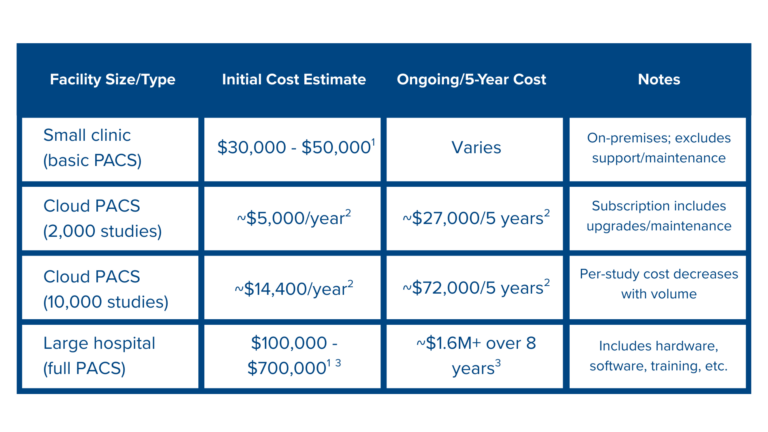From Implementation to Optimization: Mastering Your PACS for Superior Patient Care

Imagine a modern healthcare system where critical diagnostic images – X-rays, MRIs, CT scans, ultrasounds – are instantly accessible to authorized personnel, regardless of location. This seamless flow of visual information is made possible by the Picture Archiving and Communication System (PACS), a sophisticated digital ecosystem that has fundamentally transformed medical imaging. Replacing outdated film-based methods, PACS acts as a central command center for image management, empowering healthcare professionals to access and interpret vital diagnostic data with unprecedented speed and efficiency.
The role of a robust PACS is undeniably critical in today’s healthcare landscape. It optimizes workflows, enhances the precision of diagnoses, fosters collaboration among medical teams, and ultimately contributes to superior patient care. However, the path to implementing and effectively managing these intricate systems presents significant challenges for healthcare organizations.
The potential earnings for hospitals and healthcare systems that successfully implement PACS are substantial though. Faster image retrieval and reporting can lead to quicker turnaround times and increased patient volume. Improved diagnostic accuracy can contribute to better treatment outcomes and reduced costs associated with errors or readmissions. Furthermore, the ability to offer seamless and efficient imaging services can enhance patient satisfaction and attract more patients. Conversely, a slow or unreliable PACS system can lead to delays, clinician frustration, and ultimately, patients choosing other facilities for their imaging needs, directly impacting the bottom line.
This is where Medix Technology offers invaluable support. We understand the unique complexities involved in PACS implementation and management and are dedicated to providing tailored solutions and expertise to ensure your system not only operates flawlessly but also drives clinical excellence and financial success for your organization.
Key Considerations for Effective PACS Implementation
Successful PACS implementation hinges on a meticulous approach to several critical factors, all requiring specialized IT expertise to navigate effectively:
- Seamless System Integration: The PACS must seamlessly integrate with your existing healthcare IT infrastructure, particularly your EHR/EMR system. This ensures that imaging data is readily accessible within the patient’s complete medical record, fostering a holistic view of their health.
- Efficient Data Migration and Management: Migrating years’ worth of legacy film and digital images to the new PACS requires a robust strategy to ensure data integrity, accuracy, and accessibility. Effective ongoing data management is equally crucial for maintaining system performance.
- Robust Network Infrastructure and Bandwidth: The transmission of large medical image files demands a reliable and high-bandwidth network infrastructure. Inadequate bandwidth can lead to frustrating delays in image loading and reporting, hindering workflow efficiency.
- Stringent Security and Compliance (HIPAA): Protecting sensitive patient data is paramount. PACS implementation must adhere to strict security protocols and comply with regulations like HIPAA to safeguard patient privacy and confidentiality.
- The Ongoing Importance of PACS System Upgrades: The healthcare technology landscape is constantly evolving. Regular PACS system upgrades are essential to maintain optimal performance, enhance security measures against emerging threats, and leverage new features and functionalities, such as PBR (PACS based reporting), MDT (multi-disciplinary team), and Imaging AI, that can further improve workflow efficiency and diagnostic capabilities.
The Surge in PACS Demand: Evolving Implementation Approaches
The landscape of PACS implementation is undergoing a significant shift. Over the past nine months, Medix Technology has observed a striking 80% increase in PACS-related job orders from our health system clients. We believe this surge is indicative of several converging factors driving a more dynamic approach to PACS adoption and modernization.
Traditionally, hospitals often undertook large-scale, capital-intensive PACS implementations as standalone projects. However, we are seeing a growing trend toward more phased and modular approaches, allowing for better scalability and reduced upfront investment. This allows healthcare organizations to adapt more readily to evolving needs and technological advancements.
Furthermore, a significant driver for PACS updates and implementations extends beyond the need for interoperability with new electronic health record (EHR) systems, although that remains a key factor. We are also seeing a substantial push driven by consistent mergers and acquisitions across the healthcare landscape. The desire to standardize technology and achieve data consistency across newly integrated health systems is a major catalyst for PACS upgrades and consolidations. Organizations are recognizing the inefficiencies and complexities of managing disparate PACS systems and are actively seeking to establish unified platforms.
Cloud-based PACS solutions are also gaining traction, offering enhanced flexibility, potentially lower infrastructure costs, and often, streamlined integration capabilities with modern EHR systems and the ability to more easily consolidate data from acquired entities. This evolving landscape, fueled by the need for EHR integration, the drive for standardization post-M&A activity, and the adoption of more flexible deployment models, underscores the increasing importance and complexity of PACS management within modern healthcare organizations.
Understanding the Costs of PACS
Implementing and maintaining a PACS involves both upfront and ongoing financial considerations. Initial costs typically include software licensing, hardware acquisition (servers, workstations, monitors), integration with existing systems like EHR/EMR, data migration from legacy systems, project management, and staff training.
Ongoing expenses encompass software maintenance and support, hardware upkeep or replacement, IT staffing dedicated to PACS, network costs associated with image transfer, data storage (which scales with image volume), and ensuring continuous security and regulatory compliance (e.g., HIPAA).
The overall investment varies significantly based on the facility size, the complexity of the chosen PACS solution, and the deployment model (on-premises vs. cloud-based). Understanding these cost components is essential for effective financial planning.
PACS Implementation and Maintenance Cost Estimates
Note: These are estimated costs and can vary based on specific vendor pricing, customization requirements, and the existing IT infrastructure of the facility. Cloud-based PACS often present different cost structures compared to traditional on-premises solutions, typically involving subscription fees that may include maintenance and upgrades.
Optimizing Your PACS for Enhanced Workflow and Patient Care
With the successful implementation of your PACS, the next crucial step is optimization — a continuous process that yields benefits across the Quadruple Aim of healthcare: enhancing patient experience, improving population health, reducing costs, and bolstering provider well-being. A well-configured and continuously refined PACS plays a vital role in achieving these interconnected goals
- Faster Image Retrieval and Reporting: Just as a well-integrated system (a key consideration during implementation) ensures seamless data flow, a properly optimized PACS facilitates rapid access to images. This allows radiologists to review studies more efficiently, leading to quicker report turnaround times. This not only improves workflow efficiency but also reduces pressure and potential burnout, directly contributing to provider well-being by allowing them to manage their workload more effectively. Faster reporting also means quicker diagnoses and treatment plans for patients, enhancing the patient experience
- Improved Diagnostic Accuracy: Leveraging the high-quality digital images and advanced viewing tools inherent in a modern PACS (often a focus during the hardware and software selection phase of implementation), optimization involves configuring these tools for maximum clarity and utility. This can include customized viewing protocols and image manipulation capabilities that enhance diagnostic confidence and reduce the potential for errors, directly improving the quality of care and the patient experience. Accurate diagnoses are also foundational for effective treatment and management strategies, contributing to better population health outcomes.
- Enhanced Collaboration and Remote Access: Building on the network infrastructure established during implementation, optimization ensures seamless collaboration among radiologists, referring physicians, and specialists, regardless of their physical location. Secure remote access capabilities, properly configured during setup, enable timely consultations and expert opinions, improving patient care coordination and the patient experience. This ease of collaboration can also reduce feelings of isolation and improve the sense of teamwork among providers, positively impacting provider well-being.
- The Importance of Ongoing System Maintenance and Support: Just as ongoing maintenance was highlighted as a key cost consideration, it’s also crucial for sustained optimization. Regular system checks, performance tuning, and timely support ensure that the PACS continues to function at its best, maximizing the initial investment and the positive impact on workflow, diagnostic accuracy, collaboration, and ultimately, the Quadruple Aim – including a positive patient experience and improved provider well-being.
Neglecting optimization can lead to a sluggish PACS, negating the benefits of a well-planned implementation. Delays in image loading and reporting can frustrate clinicians (despite the initial efforts in integration), postpone diagnoses, and ultimately lead to patients seeking imaging services at facilities with more efficient systems – directly impacting the hospital’s bottom line.
Unlock Your PACS Potential with Medix Technology’s Custom Solutions
At Medix Technology, we understand that every healthcare organization has unique needs and challenges when it comes to PACS. That’s why we offer tailored solutions designed to address your specific requirements and ensure a seamless and efficient PACS experience. We understand the need to augment your existing teams with specialized expertise, offering a cost-effective alternative to relying solely on often expensive vendor labor.
Our expertise encompasses:
- Comprehensive PACS Implementation Support: From initial planning and system selection to seamless integration with your existing infrastructure and efficient data migration, our experienced team provides the guidance and technical expertise you need for a successful implementation.
- Dedicated and Experienced Resources for Augmentation: Medix Technology offers the ability to augment your in-house IT staff with dedicated, experienced PACS professionals. These resources can provide client-side support, manage specific projects, assist with system upgrades, or handle day-to-day PACS administration, providing valuable expertise without the high costs associated with direct vendor labor.
- Scalable and Flexible Support Options: Whether you need ongoing technical support, assistance with complex system upgrades, or expert guidance on optimizing your workflow, Medix Technology offers flexible and scalable solutions to meet your evolving needs. Our dedicated resources can adapt to your changing requirements, providing the right level of support when and where you need it most.
By partnering with Medix Technology, you gain access to a team of dedicated experts who are committed to ensuring your PACS system operates at peak performance from implementation to optimization, allowing you to focus on what matters most: providing exceptional patient care. Let us help you navigate the complexities of PACS management and unlock the full potential of your imaging infrastructure.
References:
- Les Trachtman, “How Much Does a New PACS Cost?,” Purview, December 14, 2021, https://www.purview.net/blog/how-much-does-a-new-pacs-cost
- “What is a PACS System? Elevate Your Medical Imaging Facility,” ramsoft, October 20, 2023, https://www.ramsoft.com/blog/pacs-system
- Ying-Chen Fang, “Financial Assessment of a Picture Archiving and Communication System Implemented all at Once,” PubMed Central, https://pmc.ncbi.nlm.nih.gov/articles/PMC3045175/




